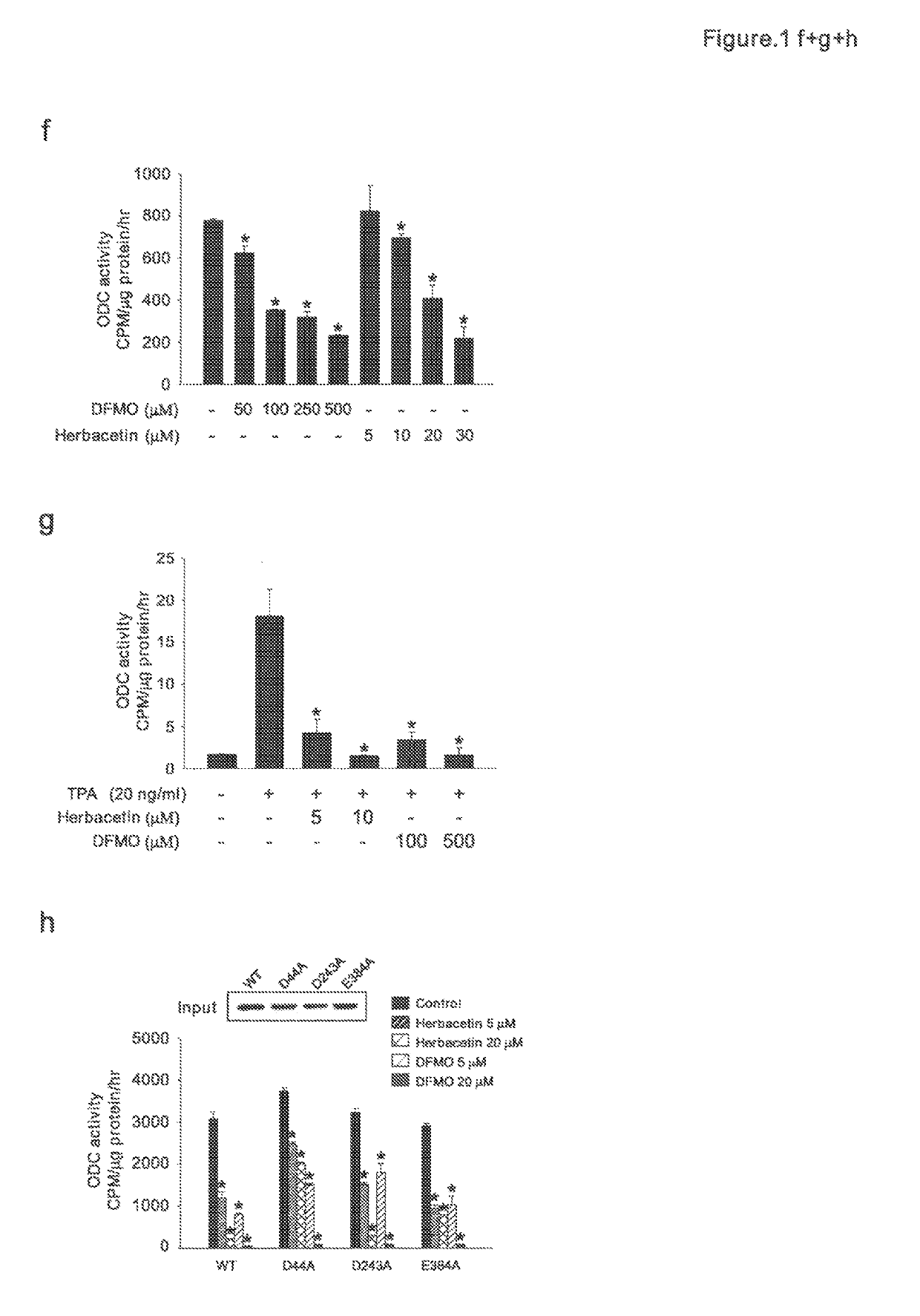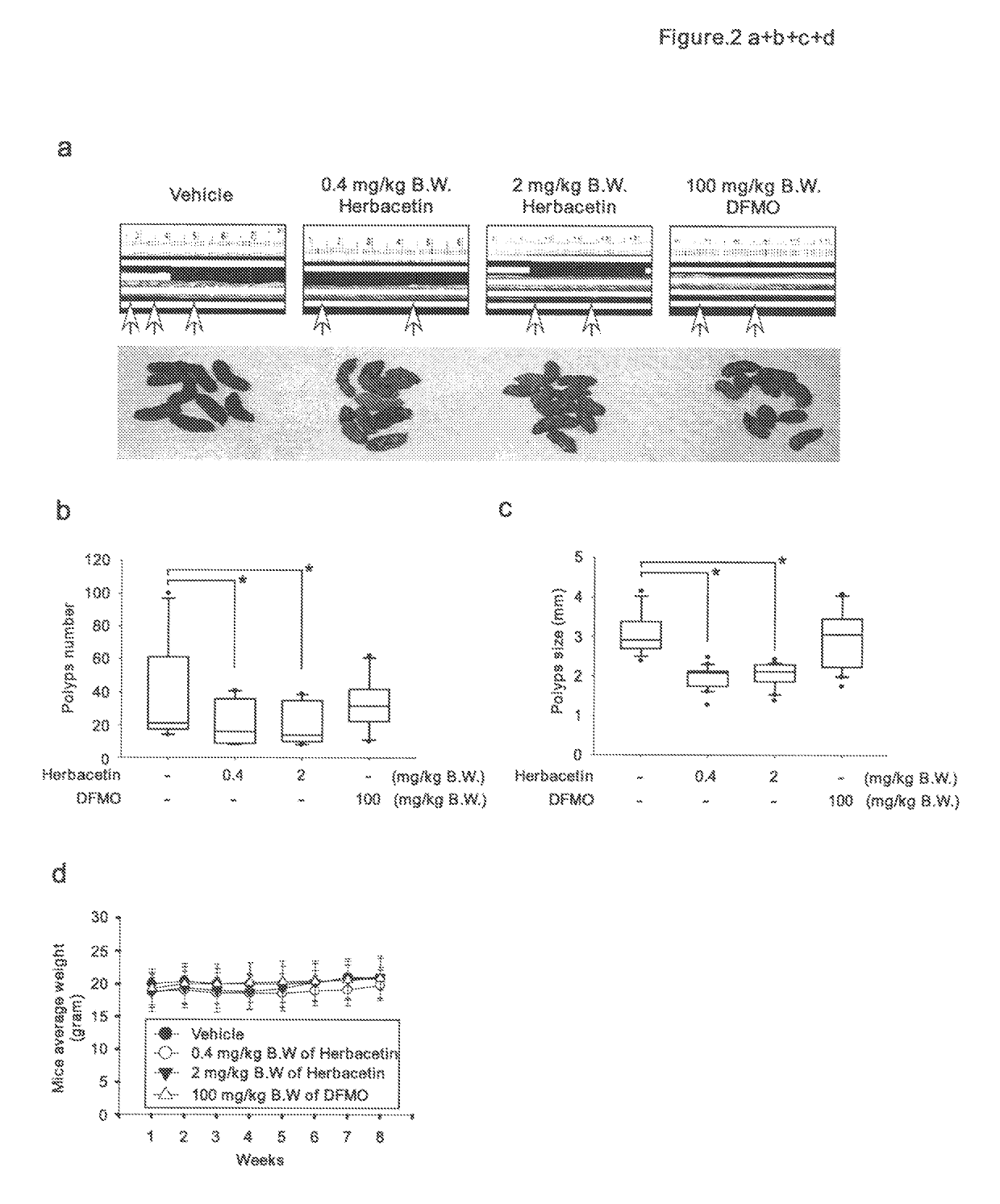Methods of treating cancer with herbacetin
a cancer and herbacetin technology, applied in the field of herbacetin treatment methods, can solve problems such as toxicity and its association with activity
- Summary
- Abstract
- Description
- Claims
- Application Information
AI Technical Summary
Benefits of technology
Problems solved by technology
Method used
Image
Examples
example 1
Herbacetin Suppresses Tumor Growth in Colon and Skin
[0056]Ornithine decarboxylase (ODC) is a first step rate-limiting enzyme in polyamine biosynthesis (Casero, R. A., Jr. & Marton, L. J. Targeting polyamine metabolism and function in cancer and other hyperproliferative diseases. Nat Rev Drug Discov 6, 373-390 (2007)). It is highly expressed in many cancer cell types and promotes growth and tumor formation (Gerner, E. W. & Meyskens, F. L., Jr. Polyamines and cancer: old molecules, new understanding. Nat Rev Cancer 4, 781-792 (2004)). Difluoromethylornithine (DFMO) is an approved FDA drug that acts as an irreversible and specific ODC inhibitor, and reportedly prevents carcinogenesis, especially in the skin and colon (Weeks, C. E., Herrmann, A. L., Nelson, F. R. & Slaga, T. J. alphaDifluoromethylornithine, an irreversible inhibitor of ornithine decarboxylase, inhibits tumor promoter-induced polyamine accumulation and carcinogenesis in mouse skin. Proc Natl Acad Sci USA 79, 6028-6032 (1...
example 2
[0083]Many components derived from dietary or medicinal plants possess substantial chemopreventive properties. Herbacetin (3,5,7,8,4′-Pentahydroxyflavone; 304.252 g / mol) is an aromatic organic compound with the molecular formula C15H12O7. It occurs naturally in flaxseed. Our preliminary data indicate that herbacetin can 1) bind to ornithine decarboxylase (ODC); 2) inhibit TPA-induced ODC1 activity; 3) suppress promoter activities of activator protein-1, Cox2, NF-kappaB; 4) decrease cell proliferation and anchorage independent colony formation of JB6 mouse epidermal skin cells. We have completed one skin cancer prevention animal study and pilot colon cancer studies.
[0085]For the effect of herbacetin on preventing TPA-induced skin cancer, SKH-1 hairless mice were divided into 5 groups of 26-30 mice / group. All mice were initiated with 200 nmol DMBA applied topically on the dorsal surface. Two weeks later, TPA (17 nmol) was applied topically on the dorsal su...
example 3
[0097]Athymic nude mice were inoculated in the right flank with HCT116 cells. Tumors were allowed to grow to an average of 40 mm3 and then mice were divided into four equal groups with the same average tumor volume (FIG. 10). Treatment was initiated on Day 8 and continued to Day 20. The asterisk (*) indicates that the tumors from the vehicle-treated group were significantly large in volume than any of the three treated groups. No difference between treatment with 0.4 mg / kg B.W. herbacetin, 2 mg / kg B.W herbacetin or 200 mg / kg DFMO was observed. This result suggests that herbacetin is a much more potent (based on concentration) therapeutic agent than DFMO.
PUM
| Property | Measurement | Unit |
|---|---|---|
| body weight | aaaaa | aaaaa |
| body weight | aaaaa | aaaaa |
| body weight | aaaaa | aaaaa |
Abstract
Description
Claims
Application Information
 Login to View More
Login to View More - Generate Ideas
- Intellectual Property
- Life Sciences
- Materials
- Tech Scout
- Unparalleled Data Quality
- Higher Quality Content
- 60% Fewer Hallucinations
Browse by: Latest US Patents, China's latest patents, Technical Efficacy Thesaurus, Application Domain, Technology Topic, Popular Technical Reports.
© 2025 PatSnap. All rights reserved.Legal|Privacy policy|Modern Slavery Act Transparency Statement|Sitemap|About US| Contact US: help@patsnap.com



